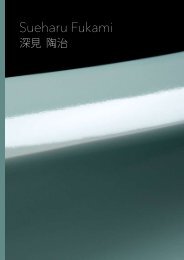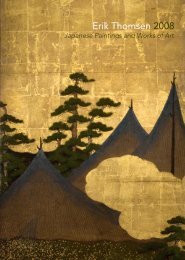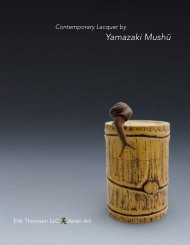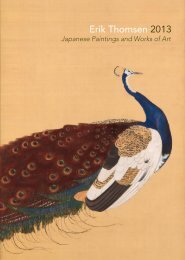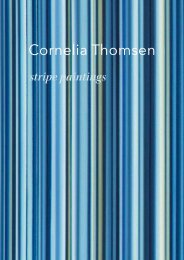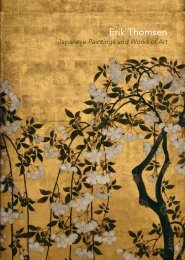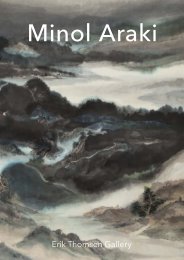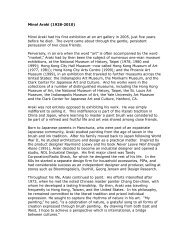View publication (pdf file 6.5 mb) - Erik Thomsen
View publication (pdf file 6.5 mb) - Erik Thomsen
View publication (pdf file 6.5 mb) - Erik Thomsen
- No tags were found...
Create successful ePaper yourself
Turn your PDF publications into a flip-book with our unique Google optimized e-Paper software.
11Hakuin Ekaku 白 隠 慧 鶴 (1685 –1768)Tenjin Traveling to ChinaEdo period (1615 –1868), circa 1760H 15 ¾" × W 5 ½" (incl. mounting 41¼" × 8 ¼")(39.9 cm × 13.8 cm, 104.5 cm × 21 cm)Hanging scroll, ink on paperInscription:唐 衣 おらで 北 野 の 神 ぞとは袖 にもちたる 梅 にても 知 れEven if you cannot tellFrom the Chinese robes he wearsYou must know that it is himFrom the plum blossomsHe holds in his sleevesFigure composed of characters:南 無 天 満 大 自 在 天 神Hail to Tenjin, God of the Tenman ShrineSeals:Hakuin 白 隠Ekaku 慧 鶴Kokan’e 顧 鑑 夷This whimsical ink painting by Hakuin is of SugawaraMichizane 菅 原 道 真 (845 – 903), a historicalfigure about whom many legends have been created.Michizane was an aristocrat and courtier atthe imperial palace in Kyoto and became a leadingscholar and poet of his generation. After beingfalsely accused by a political rival, he was exiledto Dazaifu in Kyushu, where he died in great sorrow.The legends have him come back later to the capitalcity as a malevolent ghost and cause greathavoc until the Kitano Tenmangū Shrine was builtin his honor. Eventually his court titles and honorswere restored and he was deified as a Shinto godby the Heian leaders in an attempt to calm hisangry spirit. 1As a god, Michizane took on the function of theGod of Learning and received the blossomingplum flower as his sy<strong>mb</strong>ol. Hakuin painted manyimages of Michizane and seems to have beenfond of this gentle figure of learning and culture. 2It seems fitting that the God of Learning is heredrawn entirely in characters—in the so called mojie文 字 絵 »character painting« technique. 3The inscription is from a 13th century Japanese textin which the spirit of Michizane flies across timeand space and actively interacts with leading Buddhistmonks in Japan and China, more than 300years after his death. 4 In this legend, he first appearsin 1241 in the dream of a Kyushu merchantand asks for a nu<strong>mb</strong>er of ceremonies in his honor.Despite valiant attempts by the rich merchant,they fail to satisfy Michizane,who decides to makean appearance before the Tofukuji Temple abbotEnni Benen 円 爾 弁 円 (1202 – 80) in Kyoto and askto become his student. Enni instructs Michizane togo instead to China and to seek guidance from thegreat monk Wuzhun Shifan 無 準 師 範 (1178 –249),who was Enni’s own master. Michizane follows theadvice and travels to China in a single night toappear before the Chinese monk and the two thenhold a conversation, which includes an exchangeof poetry. This journey by Michizane to Chinaforms the title of this painting. A poem uttered byMichizane is the one that Hakuin inscribed abovethe painting. During the conversation, the Chinesemonk gives Michizane a Chinese robe as a sign ofenlightenment, a robe that Michizane takes backwith him to Japan. Hakuin here depicts Michizanewith the Chinese robe that he has just receivedfrom Wuzhun Shifan.The painting is interesting on a nu<strong>mb</strong>er of points,as it represents interactions between religionsand cultures, between images and words. TheMichizane painting can be seen as a sy<strong>mb</strong>olicinteraction between China and Japan (in people,in clothing, in travel, and in text) and between54



